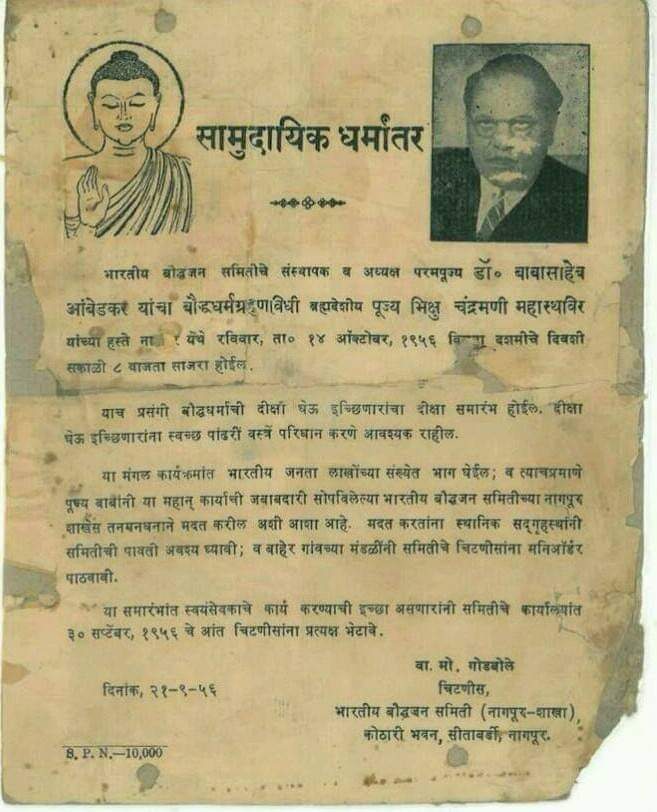
Dhammachakra Anupravartan Din – The Unique Utsav
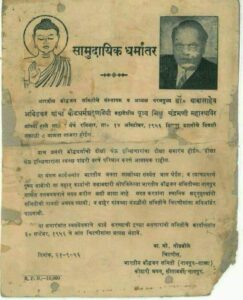
It is well-known that Dr. Babasaheb Ambedkar converted with hundreds of thousands of his followers to Buddhism on 14 October 1956 at Nagpur. The day after that Babasaheb travelled to Chandrapur, and here too his followers converted to Buddhism on 16th October 1956. Every year, masses of Dr. Ambedkar’s followers gather at the Deekshabhoomi in Chandrapur on 15th and 16th October to observe Dhammachakra Anupravartan Din.
Today I walked with a group of friends on road from Priyadarshini Chowk towards Deekshabhoomi and enjoyed the immense diversity of the stalls that had come up on either side of the road. The crowd that has gathered from across the district and even neighbouring states, seemed to increase every minute as the evening of 16 October approached with its promise of a grand annual programme in the premises of Dr. Ambedkar College, Deekshabhoomi.
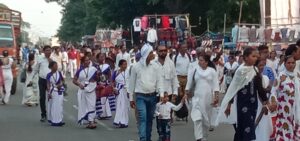
Wandering through the roadside stalls makes one appreciate the uniqueness of Dhammachakra Anuvartan Din. Undoubtedly, the day is marked to recall the memory of breaking out of the shackles of the old, unjust, caste-ridden system of Hinduism and accepting the Path of Buddha, but it is not just a commemoration of a single event of mass religious conversion but also about seeing the conversion as a part of a larger, ongoing and universal struggle for justice, equality, liberty and peace.
Dr. Babasaheb Ambedkar tied the struggle for justice with mass religious conversion and at the same time he also ensured that the process is not depressive and devoid of joy. Utsav is a word which is very difficult to translate into English. It is a combination of festivity and celebration with the observation of religious and/or cultural traditions. Dhammachakra Anupravartan Din in Chandrapur is an Utsav. The lives of the poor and the marginalised sections of society continues to be very difficult and they have to struggle hard for their rights, but this struggle is sustained by sharing of music and food as much as by exchange of ideas.
The Utsav provides space for every action imaginable that expresses empowerment and enlightenment. Each person is free to choose whichever action suits them best – some people sing about justice, others recite the Preamble of the Constitution publicly, many buy books or metal statues for their homes, a few tattoo the image or name of Babasaheb on their forearms. Every act is an assertion.
Family and friends dressed mainly in white or blue converge and exchange greetings of ‘Jai Bhim’. There are girls and young women who throng stalls selling purses, clothes and jewellery. Children tug at the parents, dragging them to the toy stalls.
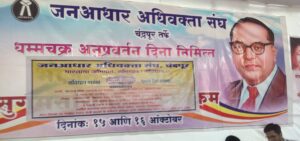
Many social organisations have set up stalls to distribute food and water to the visitors. Janadhar Adhivakta Sangh – an association of progressive lawyers has set up a free medical camp in their stall, where people can drop in to check blood pressure, sugar levels and consult a doctor. The organisation also distribute biscuit packets and water bottles to visitors.
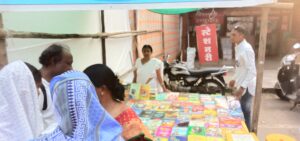
Several entertainment stalls had orchestras playing Bheem Geets – songs set on the lives of Dr. Babasaheb Ambedkar, his wife Ramai and Gautam Buddha. In one stall a group of young men were dancing to a catchy tune celebrating the triumphs of Babasaheb.
The most attractive stalls were the book stalls which sold small books on different topics and were invariably crowded with buyers. These book stalls are extremely important in taking the literature of the Dalit Movement and other progressive movements and the thoughts of Dr. Babasaheb Ambedkar to the homes of the poorest of the poor. Many of the books are small but with quality printing and cheaply priced to suit the common woman’s pocket. Some of the popular titles included various excerpts from Dr. Babasaheb’s writings and speeches, the writings of Sant Kabeer and Mahatma Jyotiba Phule, essays on various social legislation e.g. laws relating to women and children, life and teachings of Gautam Buddha, copies of the Indian Constitution in Marathi and so on. The book stalls also had small metal statues, paper weights and posters all related with Dr. Ambedkar.
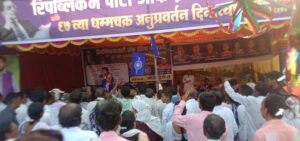
Nearly every political party and non-party political associations had stalls with volunteers making speeches. Men and women sat on plastic chairs facing large screens and intently listened to the speeches of political leaders – the stall run by Vanchit Bahujan Aghadi was playing the speech of Adv. Balasaheb Ambedkar, the stall run by RPI was playing the speech of Ramdas Athavale and another leader was speaking on the screen put up by BRSP. The only political leader who was actually present in person was the MLC Sudhakar Adbale who was talking about the Maratha Reservation Issue.
What also caught my eye were the volunteers of the Samta Sainik Dal in their blue uniforms. They were near every stall helping people, providing information, offering a hand. I spoke to one of the volunteers who was present at the stall of the advocates. He told me that he had given up Christianity four years ago and “joined Babasaheb”. He was a volunteer of the Samta Sainik Dal since the last two years and also an active member of a Buddhist Association.
The words ‘struggle’, ‘movement’ and ‘activism’ often bear dark, negative connotations of misery and torture. But Dhammachakra Anupravartan Din in Chandrapur reminds us that those words also mean songs and books, power and solidarity.
- Paromita Goswami


